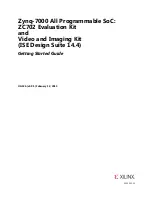
CHAPTER 5: SETTINGS
CONTROL ELEMENTS
L90 LINE CURRENT DIFFERENTIAL SYSTEM – INSTRUCTION MANUAL
5-397
5
The tripping or unblocking window for loss-of-guard without permission is the difference between the
DCUB LOG TRIP
WINDOW
and
DCUB LOG PICKUP DELAY
timers. For the default settings, this difference is 150 – 8 = 142 ms and occurs 8 ms
after loss-of-guard was received, when the
DCUB LOG PICKUP DELAY
timer has timed out. During this interval, the scheme
has permission to operate if a forward fault is sensed, and no reverse faults or transient blocking.
GUARD HEALTHY RESET DELAY
— This setting represents the guard healthy security time delay. It is the time after the channel
is restored that the guard signal must be present before the directional comparison unblocking scheme is put back in
service. This reset timer allows the scheme to ride through any chattering in the channel. Typical values are from 100 to
500 ms, with a value of 150 ms commonly used.
DCUB LOG TRIP WINDOW
— This setting represents the directional comparison unblocking lockout time delay. It is the
amount of time from when any loss-of-guard signal is received until the directional comparison unblocking scheme is
locked out without the presence of any
RX1
to
RX4
receive signal or any forward element. This timer seals-in when it
expires, creating a blocking signal for all scheme functions and disabling the scheme until the guard signal is restored and
the
GUARD HEALTHY RESET DELAY
timer expires. Typical values for this setting are from 160 to 180 ms; for most cases, a
setting of about 150 ms can be used.
DCUB SEAL-IN DELAY
— The output FlexLogic operand (
DCUB OP
) is produced according to the directional comparison
unblocking scheme logic. The
DCUB SEAL-IN DELAY
defines a minimum guaranteed duration of the
DCUB OP
pulse. As this
operand runs the trip table of the directional comparison unblocking scheme, the
DCUB TRIP A
,
DCUB TRIP B
,
DCUB TRIP C
, and
DCUB TRIP 3P
trip operands are sealed-in for the same period of time.
DCUB NO OF COMM BITS
— This setting specifies the number of bits available on the communications channel for the
scheme. With only one bit available, the scheme sends the direct under-reaching transfer trip command on bit 1 (
DCUB TX1
operand) and responds to the direct trip command received on bit 1 (
DCUB RX1
setting). The scheme uses only local fault
type identification provided by the phase selector to assert the
DCUB TRIP A
,
DCUB TRIP B
,
DCUB TRIP C
, and
DCUB TRIP 3P
output operands.
DCUB RX1
through
DCUB RX4
— These settings allow the user to select the FlexLogic operands to represent the permission
receive signals for the scheme. Contact inputs interfacing with a signaling system(s) are typically used. These settings must
be used in conjunction with the loss-of-guard signals, otherwise the scheme does not unblock and thus fails to operate.
In single-bit applications,
DCUB RX1
must be used. In two-bit applications,
DCUB RX1
and
DCUB RX2
must be used. In four-bit
applications,
DCUB RX1
,
DCUB RX2
,
DCUB RX3
, and
DCUB RX4
must be used.
DCUB LOG1
through
DCUB LOG4
— These settings allow the user to select the FlexLogic operands to represent the loss-of-
guard receive signals for the scheme. Contact inputs interfacing with a signaling system(s) are typically used. Each loss-of-
guard signal must correspond to the same receive signal from the same communications channel (that is,
RX1
and
LOG1
must be from the same communications channel, and the same for channels 2, 3 and 4, if used).
In single-bit applications,
DCUB RX1
and
DCUB LOG1
must be used. In two-bit applications,
DCUB RX1
with
DCUB LOG1
and
DCUB RX2
with
DCUB LOG2
must be used. In four-bit applications, all receive and loss-of-guard signals must be used.
Содержание L90
Страница 14: ...1 4 L90 LINE CURRENT DIFFERENTIAL SYSTEM INSTRUCTION MANUAL FOR FURTHER ASSISTANCE CHAPTER 1 INTRODUCTION 1 ...
Страница 68: ...2 54 L90 LINE CURRENT DIFFERENTIAL SYSTEM INSTRUCTION MANUAL SPECIFICATIONS CHAPTER 2 PRODUCT DESCRIPTION 2 ...
Страница 136: ...3 68 L90 LINE CURRENT DIFFERENTIAL SYSTEM INSTRUCTION MANUAL CONNECT TO D400 GATEWAY CHAPTER 3 INSTALLATION 3 ...
Страница 224: ...4 88 L90 LINE CURRENT DIFFERENTIAL SYSTEM INSTRUCTION MANUAL FLEXLOGIC DESIGN USING ENGINEER CHAPTER 4 INTERFACES 4 ...
Страница 692: ...6 36 L90 LINE CURRENT DIFFERENTIAL SYSTEM INSTRUCTION MANUAL PRODUCT INFORMATION CHAPTER 6 ACTUAL VALUES 6 ...
Страница 708: ...7 16 L90 LINE CURRENT DIFFERENTIAL SYSTEM INSTRUCTION MANUAL TARGETS MENU CHAPTER 7 COMMANDS AND TARGETS 7 ...
Страница 742: ...9 6 L90 LINE CURRENT DIFFERENTIAL SYSTEM INSTRUCTION MANUAL TESTING CHAPTER 9 COMMISSIONING 9 ...
Страница 804: ...10 62 L90 LINE CURRENT DIFFERENTIAL SYSTEM INSTRUCTION MANUAL FAULT LOCATOR CHAPTER 10 THEORY OF OPERATION 10 ...
Страница 872: ...C 6 L90 LINE CURRENT DIFFERENTIAL SYSTEM INSTRUCTION MANUAL COMMAND LINE INTERFACE APPENDIX C COMMAND LINE INTERFACE C ...
Страница 878: ...D 6 L90 LINE CURRENT DIFFERENTIAL SYSTEM INSTRUCTION MANUAL REVISION HISTORY APPENDIX D MISCELLANEOUS D ...
Страница 882: ...iv L90 LINE CURRENT DIFFERENTIAL SYSTEM INSTRUCTION MANUAL ABBREVIATIONS ...
Страница 900: ...xviii L90 LINE CURRENT DIFFERENTIAL SYSTEM INSTRUCTION MANUAL INDEX ...
















































